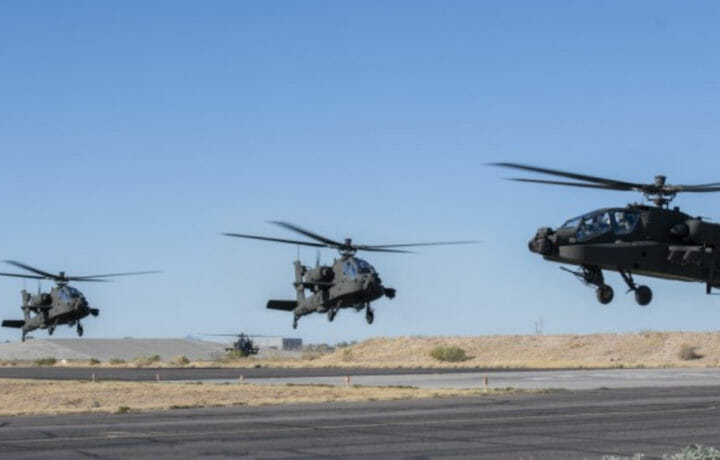Last month, United States Army grounded its aviation unit for training following a number of helicopter crashes, including two within a month that occurred in Alaska and Kentucky. The training involved all active duty Army aviators except those participating in critical missions. It took place between May 1 and 5 – while Army National Guard and Reserve units will have until May 31 to complete the training.
For some U.S. Army aviators, the temporary grounding was likely the least of their immediate concerns. Due to a clerical error, some pilots will be forced to remain in the cockpit for an additional three years longer than anticipated.
The issue came about last month after the Army Human Resources Command discovered a contract issue when a handful of officers submitted routine paperwork to be released from active duty. The Army, believing those pilots still had three years to serve, then conducted an audit and found that this “error” impacted roughly 600 people.
It was reported earlier this month that at least 190 active duty pilots may have voluntarily resigned years ahead of schedule due to an error in those the Human Resources Command had been tracking and applied their commitments.
Understanding BRADSO
The issue came about due to a program known as BRADSO (Branch of Choice Active-Duty Service Obligation), where cadets commissioning from the U.S. Military Academy or Army Cadet Command from 2008 to 2020 were able to request a branch of their choice, including aviation, by agreeing to serve an additional three years on active duty. BRADSO was meant to give officers a leg-up to choose the branch they most wanted – but with the added obligation.
Army pilots already have an additional obligation of six years in uniform after they complete flight school.
However, the Army had allowed for years, some aviation officers to serve those three years concurrently, and not consecutively; along with their roughly contracted seven or eight years of service. Under the interpretation of the regulations, as it now stands, Army pilots would serve their three-year obligation from BRADSO after their six years of flight school, which would result in roughly 10 years of service.
“I want to start upfront by saying we acknowledge that there were errors in the application of aviation officers’ active-duty service obligation,” the head of Army personnel, Lt. Gen. Douglas Stitt, told reporters during a roundtable in April. “We are fixing those errors and we are in communication with the unit leadership and impacted officers. Our overall goal to correct this issue is to provide predictability and stability for our soldiers while maintaining readiness across our force.”
Unhappy Pilots
There are now more than 600 affected active-duty commissioned officers who are impacted, including many who said they were preparing to transition to civilian life and all it entails, including starting families and launching businesses. They are now in limbo and could be forced to remain in uniform for three more years.
Hundreds of the impacted officers have even organized in response, arguing that it was Army officials that fed them inaccurate information about the contract lengths.
“You feel like the Army has kind of stabbed you in the back,” one pilot, who wished to remain anonymous, told Stars & Stripes this month. “A lot of people caught up in this have a lot tougher situations — they’ve found their civilian-side work or bought a house where they want to settle or whatever. For me, it’s just kind of crushing an option I thought was there.”
The Army has acknowledged that some 190 pilots probably were approved to leave active-duty service before fulfilling their BRADSO requirements. At this point, it seems unlikely the service could be forced back into their flight suits – but that is little comfort to those who are still suiting up for the Army.
There is now talk of legal action. An anonymous letter “sent on behalf of over 170 active-duty Army aviators” to Maj. Gen. Tom Drew, head of the Human Resources Command, which described itself as “The Future of Army Aviation” wrote that they were considering hiring a “prominent” attorney to resolve the matter in court.
“It is a shared view that unethically retaining officers against their will does not increase readiness or bolster retention and recruiting efforts, rather it harms the institution [the Army] and our nation,” the letter noted.
Gen. Scott said he is aware of the letter and also noted that the Army would continue to review the issue. It expects a full audit of the service obligation issue by July. Even as impacted pilots may contractually owe nine years of service beyond flight school, the service will take an individualized approach to review requests from those requesting a separation from the Army before their commitments are complete.
Shortage of Pilots
This issue comes as all of the branches of the U.S. military are struggling with recruiting – and there continues to be a serious pilot shortage. The U.S. Air Force, which was short of about 1,900 pilots last year, has brought back retired aviators to fill staff gaps, while it has also offered bonuses.
The Army now continues to lose pilots at an alarming rate, and this is a problem that has only been growing with each passing year. Extending the service commitment for those already in uniform is at best a short-term fix – and hardly even that.
The U.S. military services are now looking at how artificial intelligence (AI) can help fill some roles, but the pilot shortage is likely going to be one that will only get worse.




